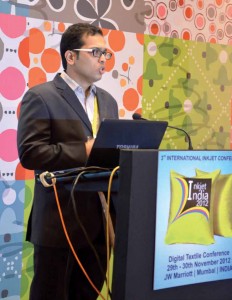 The third two-day International Inkjet Conference held in Mumbai recently laid the foundation for the growing Indian digital textile industry and also showcased various aspects, including printhead technology, integration systems, software, color management, printing equipments, and inks & market trends.
The third two-day International Inkjet Conference held in Mumbai recently laid the foundation for the growing Indian digital textile industry and also showcased various aspects, including printhead technology, integration systems, software, color management, printing equipments, and inks & market trends.
Mr. Stewart Partridge, Director – Asia Pacific (Sepiax Ink Technologies and Chimigraf Ibérica SL), who is an expert in the field of inkjet, was the co-convener for Inkjet India 2012.
He opened the event with his keynote address on “Textiles’ Position in the Digital Printing World”, providing an overview of where digital textile fits into the digital printing world and what is driving the current and future developments from inside and outside the textile industry.
This was followed by the global launch of the aqueous textile version of the Fujifilm Dimatrix SG1024 by Mr. James Gill, Director – Emerging Markets, Fujifilm Dimatrix. He deliberated on the advantages and disadvantages of digital textile printing and also emphasised the need for communication among textile mills, printhead manufacturers, ink manufacturers and digital print equipment providers for the growth of this technology in India.
The next session saw Mr. Steve Smith (DP Innovation inc.) speak about the importance of software technology to improve the digital textile printing business. He covered interesting topics, including the need to choose the right profile for textiles, color communication and solutions available for developing a web-based printing service.
This was followed by a software & electronics perspective which dealt with the challenges for system builders for developing high-speed large inkjet textile systems.
The post-lunch presentation by Mr. Mack Xin (Human Digital) provided the delegates an overview of the development of the Chinese inkjet manufacturing base and the status of inkjet textile in China.
The next presentation made by Dr. Geeta Mahale provided highlights of her current study to explore and process different types of textile designs using CAD applications and the image quality of digitally printed textiles. Twenty-one samples were selected for the study and categorized under five types of textile designing – weaving, printing, painting, tie-dye and embroidery.
Mr. Aditya Chandavarkar, CEO of Inkjet Forum India, in his address, provided an insight into the Indian conventional and digital textile printing market, the future of digital textile printing in India, and the key issues that need to be addressed for this technology to be successful in India.
With an interactive panel discussion on the intricacies of digital textile printing & market trends the first day’s proceedings ended. The second day witnessed presentations by technology providers deliberating on the recent developments in printing & ink technology. Leading companies, including MS srl, Kornit, Stork Prints, Regianni and Konica Minolta, participated in the conference that concluded on a positive note with an interactive session titled “Digital Textile Printing – The Way forward” chaired by Mr. Stewart Partridge.
This session focussed on the importance of color management & printer maintenance and the need for constant communication among textile millowners, printhead manufacturers, OEMs and ink & software providers. It also emphasised the need for appropriate training for operators and millowners.
Digital textile printing is bringing about a technology revolution the world over. However, the Indian textile industry is a little cautious in taking to digital textile printing as there are many technical challenges which need to be addressed.
Digital textile printing overall is an interesting technology and provides exciting avenues for new product development, innovation and value addition to the end users. However, it is not a technology where you can simply install a printer, put in the fabric and print. Running a digital textile printer at optimum production level is a combination of correct choice of the machine, inks and RIP software to suit your production volume, quality and fibres; appropriate training from the machine manufacturers, RIP software suppliers, inks manufacturers & allied service providers to the end user to optimally use the entire digital textile printing package; accurate feedback & documentation from the end user to the technology suppliers to resolve issues efficiently; investment of time by the end user to train print technicians/masters; timely follow-up of the maintenance schedule by the end-user and use of approved spares, inks to avoid downtime; and continuous interaction between suppliers and end-users.
The primary objectives of Inkjet Forum India are to help the printing industry remain updated with technological developments, and understand the various applications and market trends in the areas of digital textile printing, ceramic inkjet printing, industrial inkjet and printing inks. It hosts comprehensive and informative conference and seminar programs for the Indian inkjet industry.
With its core team having comprehensive knowledge of conventional & inkjet printing technology and a combined experience of two decades, Inkjet Forum India also brings together more than 15 years of experience in organising events with in-depth understanding of the current and future printing market trends.